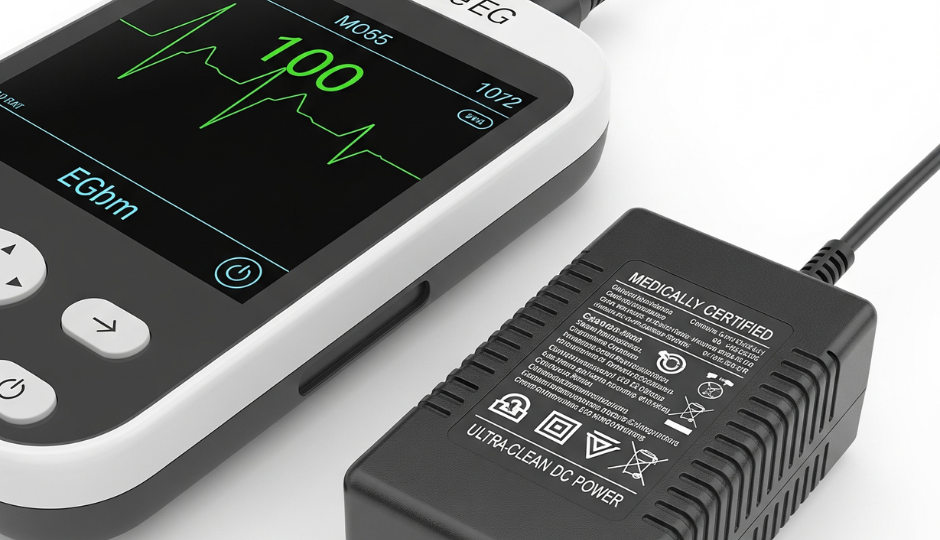A remote ECG monitor may seem small, but if its power source is unstable, the results could be inaccurate, delayed, or even lost during critical moments.
A remote ECG device needs a power adapter that ensures low noise, consistent output, and full compliance with medical safety standards to guarantee accurate signal capture and safe wireless transmission.
Today, wearable and remote ECG monitors are used in home care, ambulances, and outpatient environments. These devices transmit cardiac data in real time. If the power adapter introduces noise or fluctuates, it can lead to false readings or data loss. For product designers, that’s not just an inconvenience—it’s a failure that can cost lives.

What Power Challenges Are Unique to Remote ECG Devices?
Remote ECG devices face a dual challenge: they must be precise like hospital-grade machines, but also compact and mobile.
Remote ECG devices require power adapters that are lightweight, energy-efficient, medically certified, and capable of delivering ultra-clean DC power without adding electromagnetic noise.
Dive deeper: Why mobility changes the power game
When we developed our first solution for a Bluetooth-enabled ECG patch, we quickly found that traditional power supplies didn’t meet the signal integrity requirements. The output voltage was clean under test loads, but in real-world use, the ripple created minor but constant interference. This translated into erratic waveform readings, especially during motion.
We solved it by using a switching power adapter with medical-grade isolation, EMI shielding, and a tight regulation of ±5%. Here’s what made a difference:
| Power Factor | Why It Matters in Remote ECG |
|---|---|
| Compact Size | Must fit tight enclosures or be external |
| Low EMI/RFI | Prevents data transmission interference |
| Stable Voltage Regulation | Maintains signal fidelity during spikes |
| IEC 60601 Certification | Ensures safety for patient-worn devices |
| Energy Efficiency (DOE VI) | Extends battery runtime and reduces heat |
If you’re designing for mobility and clinical-grade performance, the adapter must check all of these boxes.
Can Wireless ECG Systems Use Generic USB Chargers?
It may be tempting to power wireless ECG monitors with off-the-shelf USB chargers—but that’s a risk.
Generic USB chargers often lack medical insulation, emit high ripple noise, and may not meet the IEC 60601-1 leakage current requirement for patient-connected devices.
Dive deeper: The risks of using non-medical power adapters
A team we worked with once decided to use a popular 5V 2A USB wall charger during pilot tests for a remote cardiac patch. They experienced sudden device shutdowns and irregular readings. Eventually, they discovered the charger introduced voltage spikes during Wi-Fi data bursts. Worse, during EMC pre-compliance testing, the charger failed to pass both conducted emissions and isolation leakage.
These were the key problems they faced:
| Problem | What It Caused |
|---|---|
| Lack of Isolation | High leakage current, failed IEC test |
| Ripple Voltage >50mV | ECG signal distortion, false arrhythmia flags |
| Voltage Drop on Load | Device resets during Bluetooth sync |
| No EMI Shielding | Data loss during live transmission |
To avoid this, I always recommend using medical adapters specifically tested for low-noise, patient-connected equipment—even if the device is “just wireless.”

How Does Adapter Power Rating Affect Remote ECG Function?
It’s not just about certification—power rating matters too, especially when the ECG device transmits in real time.
The adapter must provide enough headroom for both idle operation and peak loads, including wireless communication surges, without causing voltage sag or shutdowns.
Dive deeper: Finding the right output wattage
In many designs I’ve seen, the base power consumption of a remote ECG module is low, often under 1W. But when it connects via Bluetooth, syncs with a mobile app, or transmits to the cloud, the load can momentarily spike by 50–70%. That’s when underpowered adapters fail.
Here’s a real example:
| ECG Operation Mode | Typical Load (W) | Instantaneous Spike (W) |
|---|---|---|
| Monitoring (idle) | 0.5 | 0.8 |
| Bluetooth pairing | 0.6 | 1.2 |
| Wi-Fi sync / OTA update | 0.8 | 1.5 |
So we recommend selecting an adapter rated at 2–3W minimum with fast transient response. This ensures reliable operation even when the device performs background tasks or firmware updates. You want the power supply to be invisible—to just work.

Do Medical Certifications Still Matter for At-Home Devices?
Yes, especially for remote cardiac monitoring devices used outside the hospital.
All ECG equipment that touches or monitors patients still requires IEC 60601-1 certified power supplies, even when used in home care or wearable form.
Dive deeper: Why home-use ECG still demands hospital-grade power
One product team argued that their remote ECG patch didn’t need IEC certification since it was powered via USB in homes. But regulators in the EU and the US disagreed. Their device was skin-contact and considered a Class II medical device. The adapter had to meet IEC 60601-1 safety and 60601-1-2 EMC standards.
Here’s why these standards apply regardless of setting:
| Standard | What It Covers | Why It’s Required |
|---|---|---|
| IEC 60601-1 | Electrical safety and leakage current | Prevents shock to the patient |
| IEC 60601-1-2 | EMC compliance in RF environments | Protects data and transmission |
| EN 55011 | Industrial, Scientific, Medical emissions | Avoids disrupting nearby devices |
Remote care is still clinical care. Power safety matters just as much in a living room as in an ICU.
Conclusion
A remote ECG monitor is only as reliable as the power behind it. The right adapter ensures safety, accuracy, and performance, without compromise.




